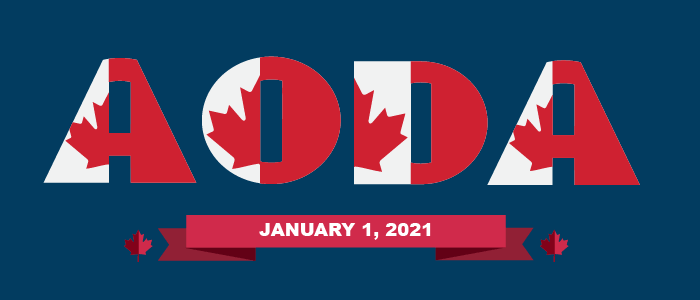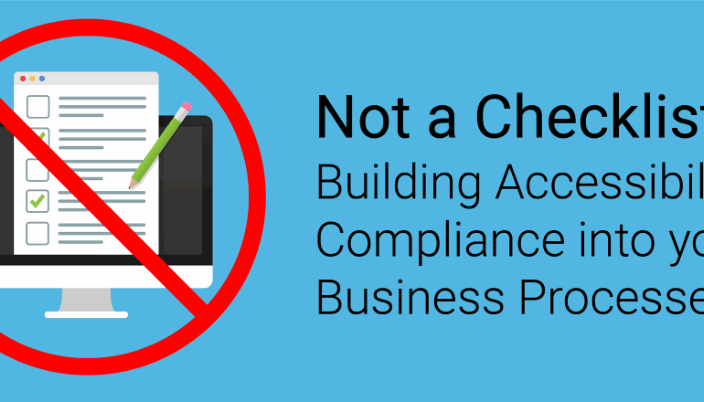What is AODA?
The Accessibility for Ontarians with Disabilities Act (AODA) is a law that was established in 2005 by the government of Ontario, Canada to develop and enforce accessibility standards for government, businesses, nonprofits, and public sector organizations.
The goal of AODA is for the province of Ontario to be accessible to people with disabilities by 2025.
Important Upcoming Deadline: All public sector organizations (including government, municipalities, and educational institutions) and all private organizations with 50 or more employees (including businesses, nonprofits, and private educational institutions) are required to be WCAG 2.0 AA accessible (excluding live captioning and audio descriptions) by January 1st, 2021.
For a full list of important filing and accessibility deadlines, please see below. Please note certain types of organizations may have varying filing deadlines depending on their size and whether they are in the public or private sector.
| Organization Type | December 31st, 2019 | January 1, 2020 | December 31st, 2020 | January 1, 2021 | December 31, 2021 | December 31, 2023 | December 31, 2025 | |
|---|---|---|---|---|---|---|---|---|
| Businesses and Nonprofits (20-49 employees) | N/A | N/A | Must File Compliance Report | N/A | N/A | Must File Compliance Report | N/A | |
| Businesses and Nonprofits (50+ employees) | N/A | N/A | Must File Compliance Report | Make all websites and web content accessible | N/A | Must File Compliance Report | N/A | |
| Private Sector Publishers (1-19 employees) | N/A | Provide other printed learning materials in an accessible format | N/A | N/A | N/A | N/A | N/A | |
| Private Sector Publishers (20-49 employees) | N/A | Provide other printed learning materials in an accessible format | Must File Compliance Report | N/A | N/A | Must File Compliance Report | N/A | |
| Private Sector Publishers (50+ employees) | N/A | Provide other printed learning materials in an accessible format | Must File Compliance Report | N/A | Must File Compliance Report | Must File Compliance Report | N/A | |
| Public Sector Publishers (1-49 and 50+ employees) |
Must File Compliance Report | Provide other printed learning materials in an accessible format | N/A | Make all websites and web content accessible | Must File Compliance Report | Must File Compliance Report | Must File Compliance Report | |
| Public Sector Organization (20+ and 50+ employees) | Must File Compliance Report | N/A | Must File Compliance Report | Make all websites and web content accessible | Must File Compliance Report | Must File Compliance Report | Must File Compliance Report | |
| Municipalities (1-49 and 50+ employees) |
Must File Compliance Report | N/A | N/A | Make all websites and web content accessible | Must File Compliance Report | Must File Compliance Report | Must File Compliance Report | |
| Public Sector Educational Institution (1-49 and 50+ employees) |
Must File Compliance Report | Provide accessible school library resources when asked
and Make printed learning materials accessible |
N/A | Make all websites and web content accessible | Must File Compliance Report | Must File Compliance Report | Must File Compliance Report | |
| Private Sector Educational Institutions (1-19 employees) | N/A | Provide accessible school library resources when asked
and Make printed learning materials accessible |
N/A | N/A | N/A | N/A | N/A | |
| Private Sector Educational Institutions (20-49 employees) | N/A | Provide accessible school library resources when asked
and Make printed learning materials accessible |
Must File Compliance Report | N/A | N/A | Must File Compliance Report | N/A | |
| Private Sector Educational Institutions (50+ employees) |
N/A | Provide accessible school library resources when asked
and Make printed learning materials accessible |
Must File Compliance Report | Make all websites and web content accessible | N/A | Must File Compliance Report | N/A | |
| Private Sector Library (20-49 employees) |
N/A | N/A | Must File Compliance Report | N/A | N/A | Must File Compliance Report | N/A | |
| Private Sector Library (50+ employees) | N/A | N/A | Must File Compliance Report | Make all websites and web content accessible | N/A | Must File Compliance Report | N/A | |
| Public Sector Library (1-49 and 50+ employees) |
Must File Compliance Report | N/A | N/A | Make all websites and web content accessible | Must File Compliance Report | Must File Compliance Report | Must File Compliance Report |
Penalties for being inaccessible
There are financial penalties for failing to comply with AODA. These can be steep, depending on the violation history of the organization and the severity of impact of the accessibility violation(s).
Below are the penalty fees for corporations– please note that self-employed individuals are exempt from this law (see: Blaney McMurty LLC).
| Impact of Violation | |||
|---|---|---|---|
| Violation History | Major | Moderate | Minor |
| Minor | $15,000 | $10,000 | $5,000 |
| Moderate | $10,000 | $5,000 | $2,500 |
| Major | $2,000 | $1,000 | $500 |
The providence and government of Ontario is not taking violations of this act lightly. In cases where the impact of violation and violation history are both determined to be major, the above amounts may be treated as a daily penalty to a maximum of $100,000.
Benefits of AODA
1) Serving a wider audience
1 in 7 people in Ontario has a disability (1.85 million people). This statistic is projected to increase to 1 in 5 people by 2036. In the next 17 years, the increasing aging population and people with disabilities will represent 40% of the total income in Ontario– that’s $536 billion dollars (Blaney McMurty LLC).
The 360,000 businesses affected by this law can no longer overlook this market share. Instead, they should view web accessibility compliance as an opportunity to widen their available target audience, opening new revenue opportunities.
2) Increased Search Presence
Accessibility can help search bots index your pages more efficiently and help them to determine when a page is or isn’t appropriate for different search terms.
In other words, accessibility can also help increase your site’s online search presence; if screen reader software can successfully navigate and find stuff on your page, then so can a Google-bot.
3) Better Overall User Experience
Studies show that optimizations made in UI/UX for accessibility also benefits people without disabilities.
For example, accessibility innovations such as captions are beneficial for people who are in a noisy location or who have English as a second language, not just people who are deaf.
Whatever the benefit, accessibility is not only a good compliance practice, it is good for business, SEO, and all of your end-users.
AODA Compliance and WCAG 2.0 AA
The Web Content Accessibility Guidelines (WCAG – often pronounced “wuh-cag”) were developed by the World Wide Web Consortium (W3C) and are widely accepted as the go-to standard for digital accessibility conformance. They serve as the basis of most accessibility regulations worldwide and are applicable across all current and future digital technologies.
WCAG has three levels of conformance: A, AA, and AAA. Level A refers to the lowest level of conformance (minimum) and Level AAA is the highest (maximum). Most organizations set their standards at level AA because it is both achievable and meaningful, without being too disruptive to the design and development process.
Simple automated accessibility tools, such as axe, can scan and identify up to 20-30% of WCAG 2.0 A and AA violations. The rest of the WCAG criteria requires manual testing and verification.
An audit is a great place to start for those who are new to accessibility, as they provide in-depth detail for all WCAG A, AA, or AAA criteria and will also include steps for remediation.
First Steps Towards Achieving AODA Compliance
- Speak to your organization’s legal counsel to make sure you understand the scope of the requirements and any deadlines you need to be aware of.
- Map out how your organization is currently meeting requirements to provide different materials in an accessible format and note which of those materials are web-based or presented in a digital format.
- Discuss future web properties your team is working on and how you plan to ensure those properties are accessible.
- Have a complete accessibility audit performed on your site and apps to determine your current level of accessibility.
- Train your developers, testers, and content creators in accessibility concepts and techniques and provide support to help them fix your accessibility issues.
- Equip your development teams with free automated accessibility scanning tools, such as axe, to integrate accessibility testing into all stages of the development process going forward.
It’s almost a year until the AODA 2021 deadline, it’s time to get started now
Depending on your organization’s number of employees and the type of organization, there are varying filing and compliance deadlines under AODA. However, most organizations with 50+ employees will need to make all websites and web content accessible by January 1, 2021.
Depending on the number of site pages, an audit and remediation project can be a lengthy process. It’s time to get started now to ensure your teams are trained and any auditing efforts are completed before the 2021 deadline.




